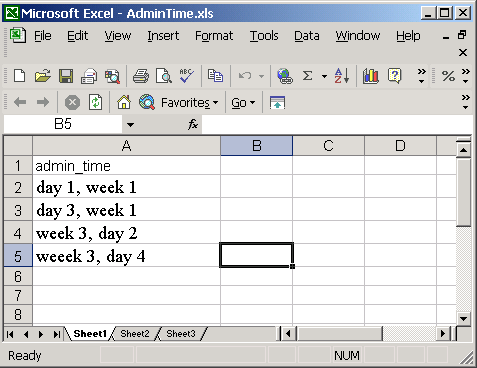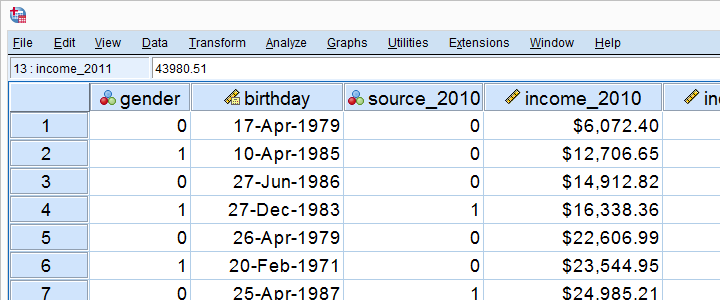

- Spss code book for excel how to#
- Spss code book for excel software#
- Spss code book for excel professional#
- Spss code book for excel zip#
If your dataset doesn’t contain any item / value labels, you can add them manually using the package sjlabelled (see here). Note that the functions get_label and get_labels will only return something if the data are labelled. # "3 Cylinders" "4 Cylinders" "5 Cylinders" "6 Cylinders" "8 Cylinders" # note: the value labels are not used for this very simple codebook. Modeling is easier done in SPSS, but SAS can provide more control thanks to command-line interface/advanced editor coding. SPSS Documentation is much better and gives better clarity on algorithms used for statistical procedures. Alternatively, it is possible to work with SPSS in syntax mode, where the user types code. Get_labels(data) # show value labels (what the different answer options mean) SPSS also provides an interface that makes it easier to learn. Get_label(data) # show content of variables (what the variable measures)
Spss code book for excel software#
Let’s first load and examine a sample dataset: library(haven) # package to read files from popular statistical software packages such as SPSS, SAS, Stataĭata <- read_sav("") # import data library(sjlabelled) # package to read and write item labels and values This should work for various file types (.sav (SPSS). A strength of this approach is that it is less error prone than updating existing codebooks (assuming the necessary information is saved in the dataframe).īut before you go through the trouble of reading this post, note that there’s also an automatic way to generate codebooks that doesn’t require any programming.
Spss code book for excel how to#
This post demonstrates how to do the latter in R: to create a simple codebook containing item names, labels, and some descriptive statistics. Researchers can either track and transfer such changes to the provisional version of the codebook or they can create a new codebook based on their dataset. About the book: Entertaining and educational, this is a genuinely accessible introductory statistics book for first year business students trying to grasp the essential concepts and techniques of quantitative analysis, using IBM SPSS and Microsoft Excel software. However, at times the initial items are more a sketch and the contents are revised when creating the study or when implementing feedback from pretesters. The variable names, labels and code lists in the SPSS file will also be imported and added to the stored documentation automatically.
Spss code book for excel professional#
Most researchers probably have some form of a codebook when they start designing their study and it might not be necessary to create one. Colectica for Excel Professional allows direct importing and documenting of SPSS data files, with a file extension. Sometimes it also describes the variables’ scale level (e.g., interval, ordinal, categorical) and answer options (e.g., 1 = strongly disagree, 5 = strongly agree not covered here). This is often done in form of a codebook, a file that lists at least the names of the variables (items) and their content. Anyone who wishes to produce copies for purposes other than those specified above must obtain the permission of the authors.A key task in empirical projects is to document the structure and content of datasets. No other permission is implied or granted to print, copy, reproduce, or distribute additional copies of this material. You may reproduce multiple copies of this material for your own personal use, including use in your classes and/or sharing with individual colleagues as long as the author’s name and institution and the Office of Teaching Resources in Psychology heading or other identifying information appear on the copied document. Modeling Depression by Rebecca KlatzkinĬhestertown, MD 2012 by Cindy J.
Spss code book for excel zip#
Note: All SPSS Data Files are all packaged into a single "zip" file that requires uncompression using standard zip format software (current operating systems typically have this ability built-in). Please read the overview of the following resources. A specific data set and a code book with summary statistics are paired with each reading duplicate data files (one in SPSS and one in Excel) are provided so that instructors have access to data in their preferred data analysis format. On the other hand, the goal of Excel is for storing the data and safely handle it. The primary purpose of SPSS is to use data manipulation techniques to fetch good results.


On the other hand, Excel is a data manipulation tool. Research readings include a brief literature review, description of an experimental method that applies to the topic at hand, critical reasoning and statistics questions, and responses to the questions posed. SPSS is a batch processing statistical tool. Littlefieldĭescription: Each of five research readings is accompanied by a data set so that students can simulate the psychological research process. Research Readings and Statistical Exercises Using SPSS and Excel (2012)Īuthor(s): Cindy J.


 0 kommentar(er)
0 kommentar(er)
